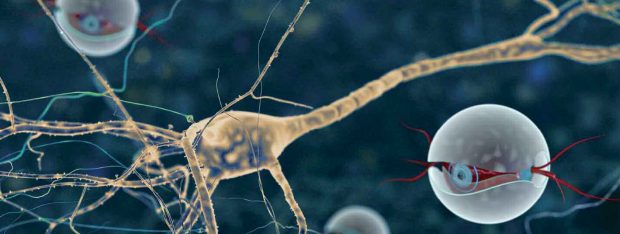 Two words: Killer nanobots.
Two words: Killer nanobots.
What’s Next For:
Revolutions?
Syria?
Mexico?
Japan?
The United States?
Earthquake Safety?
Climate Action?
California Water?
Climate Science?
Solar Energy?
California Fruit Farming?
Technology Investing?
Nanoscience?
Digital Storage?
Artificial Intelligence?
Cyber-Threats?
Social Media?
Space Exploration?
Science Museums?
The Sagehen?
Biodiversity?
The Blind?
Big Data?
Mental Illness?
Health Care Apps?
Maternity Care?
Etiquette?
Ballroom Dance?
Thrill Seekers?
Outdoor Recreation?
Funerals?
Writers?
Movies?
Manga?
Alt Rock?
Women in Mathematics?
Two more words: Just kidding.
Many of us got our introduction to nanomaterials through science fiction, where visions of lethal microscopic robots were once in vogue. Since then, the fictional outlook has gotten less bleak. “Now it’s gone from killer robots to the things that give superheroes and supervillains their powers,” jokes University of Washington research scientist Lewis Johnson ’07.
But if you’re waiting for killer nanobots, you’re likely to be disappointed, according to both Johnson and Pomona Professor of Physics David Tanenbaum. If you look closely, however, you’ll find that the real world of nanomaterials is already here—from the flash memory in your computer to the coating that makes your clothing shed spilled wine to the sunscreen you wear when you go to the beach.
And that’s just for starters.
As for what to expect in the future, Tanenbaum points to the fraudulent case of the startup Theranos, which claimed to use nanosensors to do a complete blood analysis from a single drop of blood. “That was a big boondoggle and an awful sham, but the reason they were able to pull it off is because that technology is coming,” he says. “The ability to use micromachined devices and sensors to do health care will happen, and the fact that there were some charlatans out there doesn’t mean that it’s not real.”
In fact, Pomona Professor of Chemistry Mal Johal believes nanomaterials will have a major impact throughout the practice of medicine. “For example, you may see nanovehicles that can specifically target a tumor and deliver whatever agents into that tumor and destroy it in a very highly directed manner,” he suggests. “I think medicine is where we’re likely to see a lot of the big advances.”
But whatever the next big thing in nanomaterials turns out to be, Johnson believes it is likely to be the result of a convergence of research in chemistry, physics, biology and engineering. For example, he says, his own post-doctoral work was in a cross-disciplinary technique sometimes called “biological mimicry.” In this case, he was looking at the enzyme nitrogenase, which certain bacteria use to take nitrogen from the air to make ammonia. “If we want to replicate what nitrogenase can do industrially, it needs to be put in a material that could be scaled for use in large factories,” Johnson says. And since the current industrial method of producing nitrogen fertilizers requires such high temperatures that it burns up about two percent of the world’s energy supply each year, creating a thriftier process would have a huge impact worldwide.
Johnson also believes that a similar convergence of disciplines is coming on the educational front. He got his own introduction to the field as a first-year student at Pomona, in Tanenbaum’s first-year seminar class, Nanotechnology in Science and Fiction. And he recently joined his mentor Johal to co-author an expanded new edition of the chemistry textbook Understanding Nano- materials, which now crosses over into related areas of biology and physics. “It’s probably the first undergraduate book written at that level, where a sophomore student can take this with just general chemistry, general biology, general physics preparation,” Johal explains.
So will nanomaterials be a hot new interdisciplinary field at the undergraduate level? “We’re starting to see universities forming programs specifically in nanomaterials, but as to whether it’s going to become a stand-alone field, that seems to be an open question,” Johnson says. “But as far as people getting degrees in nanomaterials at the undergraduate level, I think that’s something that would be plausible in the near term.”
